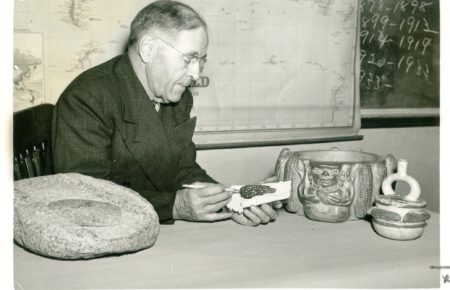
J.C. Cunningham examines artifacts for the proposed museum. Photo courtesy of Iowa State University Special Collections, Parks Library
By Jerome Thompson
Jules Cool Cunningham, professor of horticulture at Iowa State College, had an idea in the 1930s. He had a vision of establishing a National Maize Museum on Iowa State’s campus. His idea gained traction. A faculty committee was established and the college president got on board, but what sidetracked this plan and what happened to the artifacts he collected for a museum is a mystery today. Papers in the Special Collections at the Parks Library at Iowa State University and some news articles reveal this untold Iowa story.
Corn Palaces were the rage in the late 1800s in several Midwestern states. These temporary exhibition halls were often clad in corn and decorated with corn mosaics. Sioux City, for instance, had five corn palaces between 1897 and 1891. You can still visit one today in Mitchell, S.D.
These palaces and the festivals organized around them were steeped in local interests and community boosterism. Cunningham had a different notion. Iowa State College was a leader in corn science, agronomy, genetics and applied technology for corn products. The museum would trace the history of corn from pre-historic times and address topics of plant breeding, genetics, nutrition, biological sciences, modern agriculture and industrial technology.
TO READ THE ENTIRE STORY AND OTHER FASCINATING STORIES ABOUT IOWA HISTORY, subscribe to Iowa History Journal. You can also purchase back issues at the store.
